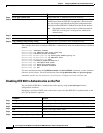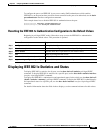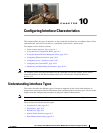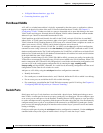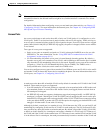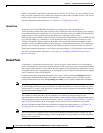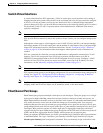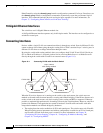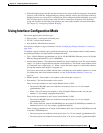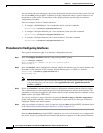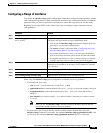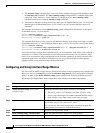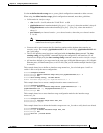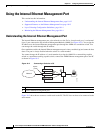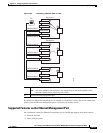
10-6
Cisco Catalyst Switch Module 3110 and 3012 for IBM BladeCenter Software Configuration Guide
OL-12189-01
Chapter 10 Configuring Interface Characteristics
Understanding Interface Types
EtherChannel by using the channel-group interface configuration command. For Layer 2 interfaces, use
the channel-group interface configuration command to dynamically create the port-channel logical
interface. This command binds the physical and logical ports together. For more information, see
Chapter 37, “Configuring EtherChannels and Link-State Tracking.”
10-Gigabit Ethernet Interfaces
The switch has one 10-Gigabit Ethernet module slot.
A 10-Gigabit Ethernet interface operates only in full-duplex mode. The interface can be configured as a
switched or routed port.
Connecting Interfaces
Devices within a single VLAN can communicate directly through any switch. Ports in different VLANs
cannot exchange data without going through a routing device. With a standard Layer 2 switch, ports in
different VLANs have to exchange information through a router.
By using the switch with routing enabled, when you configure both VLAN 20 and VLAN 30 with an
SVI to which an IP address is assigned, packets can be sent from Blade Server A to Blade Server B
directly through the switch with no need for an external router (Figure 10-1).
Figure 10-1 Connecting VLANs with the Blade Switch
When the IP services feature set is running on the switch or the stack master, the switch uses two
methods to forward traffic between interfaces: routing and fallback bridging. If the IP base feature set is
on the switch or the stack master, only basic routing (static routing and RIP) is supported. Whenever
possible, to maintain high performance, forwarding is done by the switch hardware. However, only IPv4
packets with Ethernet II encapsulation are routed in hardware. Non-IP traffic and traffic with other
encapsulation methods are fallback-bridged by hardware.
• The routing function can be enabled on all SVIs and routed ports. The switch routes only IP traffic.
When IP routing protocol parameters and address configuration are added to an SVI or routed port,
any IP traffic received from these ports is routed. For more information, see Chapter 38,
“Configuring IP Unicast Routing,” Chapter 44, “Configuring IP Multicast Routing,” and
Chapter 45, “Configuring MSDP.”
Blade
server A
Blade
server B
SVI 1172.20.128.1 172.20.129.1SVI 2
Layer 3 switch
with routing enabled
VLAN 20 VLAN 30
201763



